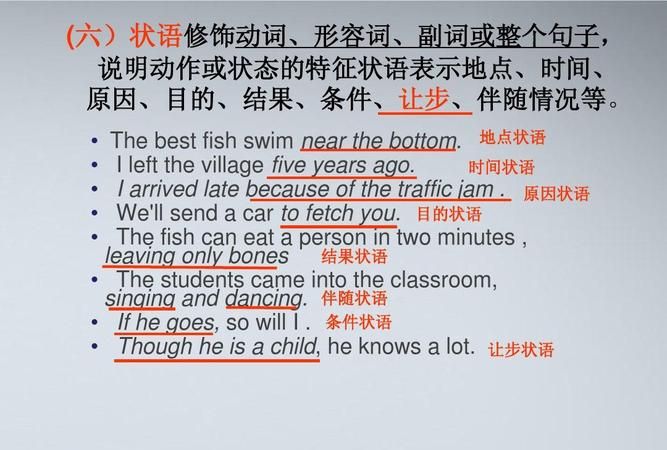本文目录
英语中目的状语是什么意思
一、用to do sth表目的
用不定式表目的是最简单也是最常用的方法,它既可以用于句末,也可用于句首,但比较而言,用于句首时,其强调意味较浓。如:
After missing a term through illness he had to work hard to catch up with the others. 他因病一学期未上课,得努力赶上其他同学。
To avoid any delay please phone your order direct. 为免延误,请直接打电话预订。
To keep themselves awake they sat on the floor and told each other stories. 为了不至于睡着,他们坐在地板上轮流着讲故事。
To avoid back problems, always bend your knees when you lift heavy objects. 为了不使背部受伤,你在扛重东西时,一定要将膝盖弯曲着。
不定式的否定式为not to do sth,而不是 to not do sth。如:
She had to struggle not to give in to a desire to laugh. 她极力控制自己不要笑出来。
Then there was the mad rush not to be late for school. 然后就是匆忙往学校赶,以免迟到。
I went to France not to study French, but to study architecture. 我去法国不是为了学法语,而是为了学建筑。
He claimed he had bought the cigarettes for home consumption, not to sell them. 他声称他买烟是为了自家享用,不是为了出售。
二、用so as to do sth表目的
so as to do sth是to do sth的变体,意思是“以便”“为了”“为的是”等。用so as to do sth表示目的时,它通常用于句末。如:
I left a message so as to be sure of contacting her. 我留下了张条子以便与她取得联系
The two lovers dropped back so as to be alone. 那对情人落在后面,为的是两人好单独在一起。
I always keep fruit in the fridge so as to keep insects off it. 我总是把水果放在冰箱里,以防虫子叮咬。
表示目的的so as to do sth有时也可放在句首(但是若so as to do sth是表示结果,则不可放在句首)。如:
So as to show his boss what a careful worker he was, he took extra trouble over the figures. 为了向老板显示他是个工作非常细心的人,他在这些数字上费了比平常更多的力气。
so as to do sth的否定式是so as not to do sth,意思是“为了不……”“以免”。如:
They tiptoed upstairs so as not to wake the baby. 他们踮着脚上楼,以免吵醒孩子。
We left in the daytime so as not to arouse suspicion. 我们在白天离开以免引起怀疑。
I shut the door quietly, so as not to wake the baby. 为了不惊醒宝宝,我轻轻地关上门。
三、用in order to do sth表目的
in order to do sth也是to do sth的变体。用in order to do sth表示目的时,它既可以用于句末,也可用于句首,但比较而言,用于句首时,其强调意味较浓。如:
She lied about her age in order to get the job. 她为了谋得那份工作隐瞒了年龄。
She arrived early in order to get a good seat. 她到得很早,图的是得个好座位。
Teamwork is required in order to achieve these aims. 完成这些目标需要团队合作。
In order to get the job you must be able to drive. 要做这项工作你得会开车。
In order to get into a good school, I must study even harder. 为了考入一个好的学校,我必须更加用功。
in order to do sth的否定式是in order not to do sth,意思是“为了不……”“以免”。如:
She slept in a separate room in order not to disturb him. 她在另一房间睡觉,为了不至打扰他。
Please reply at once in order not to lose this opportunity of a lower price. 请立即回复,以免失去这次低价的机会。
They must have worn gloves in order not to leave any fingerprints. 他们一定戴上了手套,以防留下指纹。
注意,in order to do sth 还有另外一个否定形式,那就是 not in order to do sth,其意为“不是为了……”。如:
Big farmers are moving in, not in order to farm, but in order to speculate with rising land prices. 大农场主正在不断涌进来,不是为了耕作,而是要利用不断上涨的地价进行投机。
This expression refers to encounters between ships of hostile nations. One ship might fire a shot at another, not in order to hit it, but to warn it to move. 这个表达源于敌对国船只在海上相遇时,一方可能向另一方鸣炮,不是为了击中目标,而是警告其快速离开。
四、用so that表目的
so as to和so that均可表示目的,两者的区别是,前者引出不定式,后者用以引导目的状语从句。与用so as to do sth表示目的的情形相似,so that引导的目的'状语从句通常位于主句之后。如:
I will give him a key so that he can get into the house whenever he likes. 我会给他一把钥匙,好让他能随时进来。
I got here early so that we could have a few minutes alone together. 我到这儿早些是为了我们能单独在一起待几分钟。
They wrote the notices in several languages so that foreign tourists could understand them. 他们把通知用几国文字写出来,以便让各国游客都能看得懂。
有时可省略其中的that。如:
Leave the keys out so (that) I remember to take them with me. 把钥匙放在外面,好让我记得带。
I deliberately didn’t have lunch so (that) I would be hungry tonight. 我有意没吃午饭,为的就是让自己今晚能感到饿。
so that 引导的目的状语从句有时还可置于主句之前(但是,若so that引导的从句是表示结果,则不可放在句首)。如:
So that I shouldn’t worry, he phoned me on arrival. 为了不让我担心,他一到就给我打了电话。
So that I shouldn’t forget it, I made a knot in my handkerchief. 为了免得忘记,我将手帕打了一个结。
So that the coming generation can learn the martial arts, he has recently devoted much time to writing books on the subject. 为了下一代能够学会这些武术,他近来花了许多时间著书立说。
五、用in order that表目的
in order to和in order that均可表示目的,两者的区别是,前者引出不定式,后者用以引导目的状语从句。与用in order to do sth表示目的的情形相似,in order that引导的目的状语从句可以位于主句之前或之后。如:
We arrived early in order that we could get good seats. 我们到得早,以便找到好座位。
These men risk their lives in order that we may live more safely. 这些人甘冒生命危险,为的是让我们生活更安全。
I bought a new car in order that my wife might learn to drive. 我买了一辆新车,以便我妻子学习驾驶。
In order that you may create such a picture, you have to possess certain artistic weapons. 创作这样的画,你得具有某些艺术手段。
六、用in case表目的
in case用于引导目的状语从句时,意思是“以防”“以免”。如:
He took his umbrella in case it should rain. 他带上了雨伞,以防下雨。
You’d better take the keys in case I’m out. 你最好带上钥匙,以防我不在家。
Listen out for the baby in case she wakes up. 注意听宝宝的动静,她醒来好知道。
in case 引导的目的状语从句有时也可位于主句之前。如:
In case anyone was following me, I made an elaborate detour. 为了防止有人跟踪我,我特地绕了弯路。
注:也有人认为这样用的in case 从句为原因状语从句,意思是“因为怕……”。比较:
I had a snack, just in case there was no time to eat later. 我吃了些点心,以防过会儿没有时间吃饭。(将in case译成“以防”,将之视为目的状语从句)
I had a snack, just in case there was no time to eat later. 我吃了些点心,因为怕过会儿没有时间吃饭。(将in case译成“因为怕”,将之视为原因状语从句)
Here's a contact number, in case there should be a problem. 这是联系电话,以防有问题出现。(将in case译成“以防”,将之视为目的状语从句)
Here's a contact number, in case there should be a problem. 这是联系电话,因为怕有问题出现。(将in case译成“因为怕”,将之视为原因状语从句)
七、用for fear (that) 表目的
for fear that 用于引导目的状语从句时,与 in case 大致同义,意思是“以防”“以免”。如:
He’s working hard for fear (that) he should fail. 他在努力工作唯恐他会失败。
She finally ran away for fear that he would kill her. 她最后逃走了,因为怕被他杀了。
Scientists reject a total ban for fear it will undermine efforts to stop the spread of malaria. 科学家们反对全面禁止,以免削弱为防止疟疾扩散所作的努力。
注:与in case一样,for fear that 引导的从句有时也被理解为原因状语从句,并将其翻译为“因为怕……”。比较:
Shut the window for fear that it may rain. 把窗子关上以防下雨。(将for fear that 译成“以防”,将之视为目的状语从句)
Shut the window for fear that it may rain. 把窗子关上,因为怕下雨。(将for fear that 译成“因为怕”,将之视为原因状语从句)

英语语法常用的目的状语从句联词有哪些
英语语法常用的目的状语从句联词
目的状语从句:从句部分是用以补充说明主句中谓语动词发生的目的的。

表示目的状语的从句可以由that, so that, in order that, lest, for fear that, in case等词引导;
目的状语从句的谓语常含有may, might, can, could, should, would等情态动词。
例如:
You must speak louder so that /in order that you can be heard by all.
He wrote the name down for fear that(lest) he should forget it.
Better take more clothes in case the weather is cold.
引导目的状语从句常用的连词有: that(以便),so that(以便), in order that(为了;以便),Lest(免得;唯恐), for fear that(生怕;以免)。
【例如】
Say it louder(so)that everyone can hear you.
大声说,以便大家都能听到你。
I am telling you that lest you should make a mistake.
我告诉你这一点,以免你搞错。
学习目的状语从句应注意以下两点:
(1)目的状语从句中常含有can,could,may,might,should等情态动词。
【例】
I got up early so that I could catch the first bus.
我起得很早,目的是为了赶上头班公共汽车。
(2)在口语中so可以引导目的状语从句。
【例】
We'll sit nearer the front so we can hear better.
我们坐的靠前一点,因此,我们听得清楚一点。
【注意】in order that与in order to的区别:
in order that+从句
in order to+动词原形 ( in order to后面加的那个不叫目的状语从句,叫目的状语)
目的状语从句的一个特点:由于目的都是未来的行为,
所以从句中一般用表示未来可能性时态,比如上面两句中的could。
当然还可以用will,would,can,等
结果状语从句的.连词
以下结果状语从句的一些用法。
1) so … that…/ such ….that
该句式中重要考查的是so和such的区别。应注意以下可能出现的结构:
so nice a boy that…
such a nice boy that…
so beautiful/diligent/carefully … that…
such (fine weather/great improvement) that…
2) so that
Everyone lend a hand, so that the sowing was done in time.
该句式中主要考查so that 与其它短语的区别,如:
I took no notice of him, ___ he flew into a rage.
A.for that B.so that C.in that D.but that
由于so that也可以引导目的状语从句,同学们应特别注意从句中时态的运用。
3) so much so that
该结构用于形容词或副词之后,表示"到如此程度以致于"。如:
He was very weak, so much so that he could not walk.
I long to visit Beijing, so much so that I dream about it every night.
4) 注意结构状语从句与too….to..enough to…, so… as to结构的不同。
;英语方式状语从句讲解
一、不定式作目的状语 不定式常作目的状语,为了强调可将其提至句首。 He studied very hard to pass the exam. 为了通过这次考试,他很认真地学习。 To get my help, he was very kind to me. 他对我很友好以便得到我的帮助。 此时应注意人称一致。 二、不定式复合结构作目的状语 in order to, so as to, in an attempt to等不定式复合结构可作目的状语,其后与不定式一样要接动词原形,构成否定式时应将not加在to前。为强调动作的目的性,也可将这些不定式复合结构提至句首。不定式复合结构作状语时所表动作的逻辑主语仍为主句的主语,此时也应注意人称一致的原则。 He listened to the teacher attentively in order to understand what the teacher said. 为了弄懂老师所讲,他听得很认真。 He sent her a gift so as to get her help. 为了得到她的帮助,他送了她一件礼物。 In order to buy his son a gift, he tried to save money. 为了给儿子买一件礼物,他尽量省钱。三、短语介词作目的状语 for the purpose of, with the purpose of等短语介词后接名词、代词、动名词也可引导目的状语。 He climbed to the top of the building for the purpose of looking into the distance. 他爬上楼顶极目远望。 I came here with the purpose of inviting you to the ball. 我来这儿为的是邀请你参加舞会。 四、so that, in order that引导目的状语从句 so that, in order that常引导目的状语从句,如果主从句主语一致可与so as to和in order to转换。 He hid his storybook so that his teacher couldn't find it. 为了不让老师发现,他藏起了故事书。 He often stays up late into the night in order that he can make up for the loss. (= He often stays up late into the night in order to make up for the loss.) 为了弥补失去的东西,他经常熬夜。</p>

英语状语例句20个
1.时间状语从句
when ,while, as ,before, after, since, till/until, once, every/each time, whenever, [as soon as, the moment/the minute , hardly…when no sooner…than]
1)when , while , as
都可表当……时,但有区别。
while 引起从句,表一段时间,而不是一点。有时还有对比的含义。
While she was reading the newspaper, Grandma fell asleep.
While I was reading , she was playing.
When 可表从句动作先于或后于主句中的谓语动词而发生。
When you have finished your report, you should type it out.
另:when 可表“那时、突然”之意。
I was cooking in the kitchen, when I heard a terrible sound.
as 强调动作的同时性,一边,一边
As I was washing dishes, I sang songs.
as 还可表“随着时间推移”
You will get wiser as you grow wiser.
2) as soon as, the moment/the minute , hardly…when no sooner…than
都可指“一……就” ,hardly…when 和no sooner…than 使用时通常用过去完成时,且常用倒装。
He fell asleep the moment he went to bed.
Hardly had he gone to bed when he fell asleep.
注意:
在时间状语从句中,不能出现将来时的形式。
2.原因状语从句
as , since, because, now that 等引导。
because 表直接的原因或理由,常译为因为。
since 一般表对方已知的,无须加以说明的既成事实的理由,常译为“既然”。
as 和because 语意相近,但语气较后者弱。
另外还有一个起并列连词作用的for , 只能放于后半部,表示一种推理或解释,或用作附加说明。
The day must break , for the birds are singing.
3.地点状语从句
where, wherever ;注意不要和where所引起的定语从句弄混。
We shall go where working conditions are difficult.(地点状语从句)
We shall go to the place where working conditions are difficult.(定从,有先行词)
4.条件状语从句
if , unless, so(as ) long as, so far as , in case
注意从句中不能出现将来时的形式。
5.让步状语从句
although(though), even if (though), however, whatever
注意: though (although)引起从句时,主句中不能出现but 。
as 引起从句时,要采用倒装。
Clever as he is, he doesn't study well.
6.结果状语从句
so, so (…)that , such…that 引导,放在主句之后。
7.目的状语从句
so that , in order that 引导,放于主句之后。
注意:so (…)that 和 so that 的不同。
so that 引导目的状语从句时,从句中常会出现can , may, should 等情态动词,而so…that 则没有。
I'll show it to you again so that you can see it clearly.我再演示一次以便你能看清楚些。
He showed it me again so that I saw it clearly.他又演示一次,结果我看清了。
8.方式状语从句
as, as if , as though 等引导。
as if 或as though 引导的从句,既可用陈述语气,也可用虚拟语气,表与主观上的不符。
He looks as if he is ill. (说话方认为他有病。)
He looks as if he were (was) ill.(说话方并不相信他有病)
9.比较状语从句
as…as, than , not so …as…
注意:比较状语从句部分常用省略结构。
I know you better than he does.

以上就是关于目的状语句子举例英语,英语中目的状语是什么意思的全部内容,以及目的状语句子举例英语 的相关内容,希望能够帮到您。
